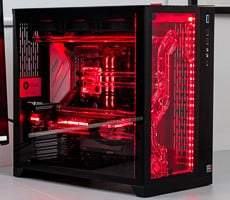AMD Unveils Radeon Software Adrenalin 2020 Edition With Radeon Boost, Streamlined Interface, New Features Galore
AMD Radeon Software Adrenalin 2020 Edition: Tuned For Performance, Ease Of Use And Great New Features
Over the last several years, AMD has released major new driver features and enhancements at the end of the calendar year, and as 2019 draws to a close, it is no different. The just-released Radeon Software Adrenalin 2020 Edition overhauls the driver suite's installation and interface to surface what's important, adds new features (and enhances several others), and promises performance improvements in a variety of games. This new driver suite supports any GCN-based Radeon going back to the December 2011 release of the Radeon HD 7970 all the way up to the latest Navi architecture and the Radeon RX 5700 XT, and works with both Windows 7 and Windows 10.
Revamped Installer
Normally we wouldn't spend a lot of time on a software installer, but there are a couple of things worth noting. Much as it has in the past, AMD's installer will check to see what driver versions are available and display them on the installer page. Radeon Software 19.12.2 is a WHQL-certified release. For Windows 10, it's just short of a 500 MB download; the Windows 7 version is a bit bigger.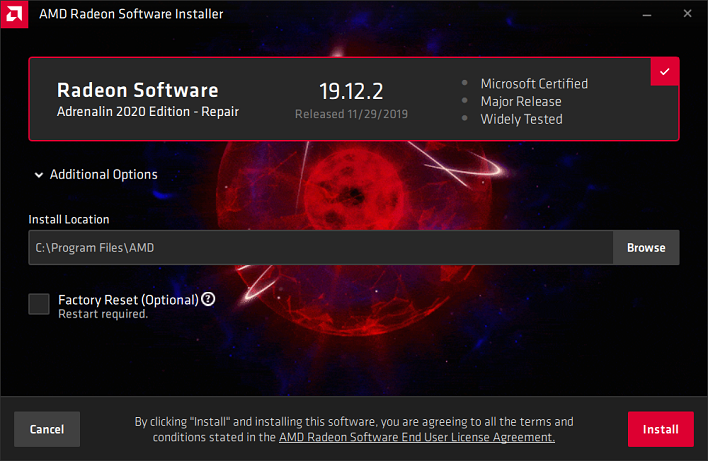
In the Additional Options is a Factory Reset checkbox which removes any previous Radeon drivers prior to installing the current one. That's really handy for troubleshooting, and if you're used to running third-party driver cleaners, you might want to give this a shot before doing so. If you check this box, the installer will remove all drivers, reboot, and then begin the installation process automatically. We've never had problems just updating the drivers automatically, and our test bed routinely switches between AMD and NVIDIA hardware, but it's great that AMD included the option.
Streamlining The User Interface
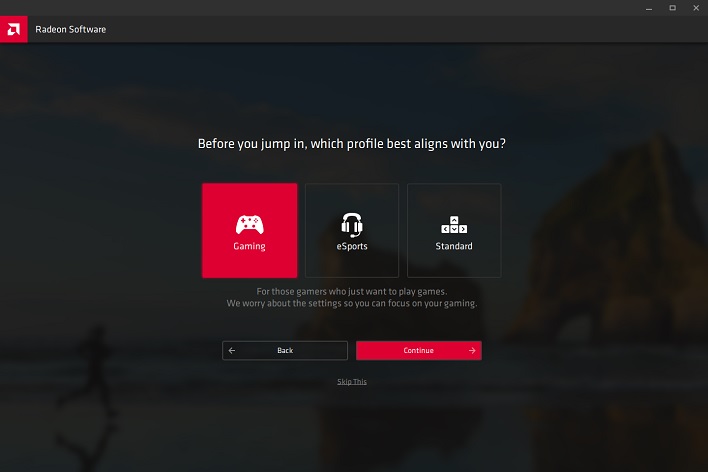
The first time the Radeon Software Adrenalin 2020 Edition started, we were prompted with a quick setup guide. Within that guide, we could choose one of three profiles. The Standard profile loads all of the system defaults we already know and doesn't turn on any additional features. Gaming and eSports turn on a combination of Radeon Image Sharpening, Anti-Lag, and Enhanced Sync. We'll talk about these features a bit more in the performance section. Once that's done, the Home screen appears.

Radeon Software Adrenalin 2020 Edition Home Screen
The Home screen is a dashboard which shows recently-played games with some quick metrics for each, some quick media capture options, AMD Link devices, and driver update status. Click on any of these areas or the tabs along the top to dive in.
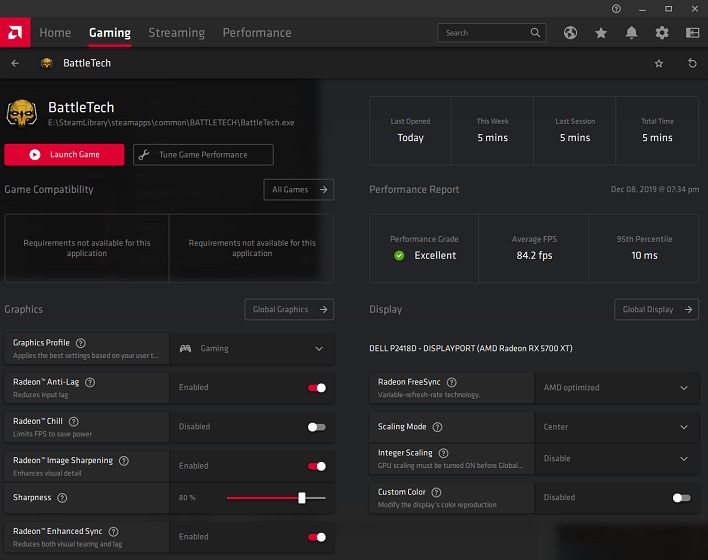
Per-game profiles are easier than ever to configure
The Gaming tab detects what supported games we have installed on our PC so we can configure settings either for each game individually or globally. Since it might not find every game installed on the system, there's an option to add a game manually or re-start the automated scan. If you choose to look at an individual game, the Radeon software shows some average performance metrics at the top. Average frame rate and 95th percentile frame time appear next to an overall performance grade. All of the various driver bells and whistles can be turned on and off for the selected game, too. The Tune Game Performance button opens the Tuning area of the Performance tab, which we'll get to shortly.
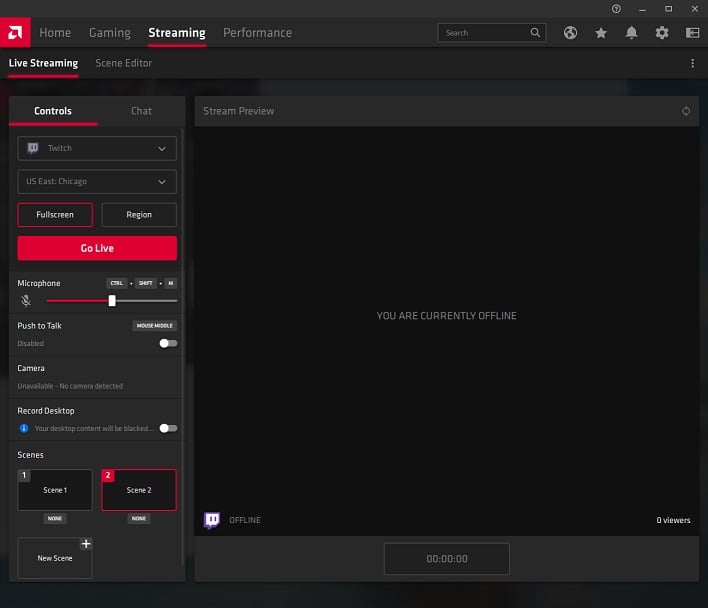
AMD's Streaming Interface has basic scene editing and quick streaming to tons of services
The Streaming tab provides handy in-driver access to Twitch, Mixer, YouTube Live, and a host of other streaming services. No extra software or hardware is required to get a stream going. If you do have extras like a webcam, the Scene Editor handles picture-in-picture, overlays, and performance monitoring all within the application. The Radeon Software application can store multiple scenes and switch scenes via hotkeys. This is a useful set of streaming tools built right into the graphics software.
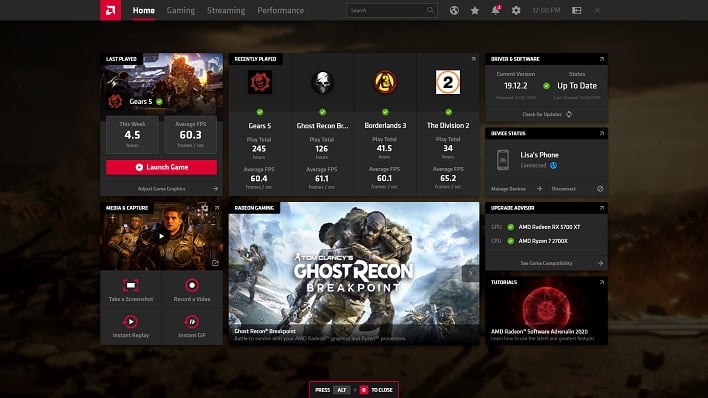
AMD Software is available in its entirety while in your favorite games (source: AMD)
These streaming options work great with one other new feature of Radeon Software Adrenalin 2020: in-game overlays. Every feature we're covering, including real-time performance monitoring, stream settings, and even graphical options like Radeon Image Sharpening are available here for on-the-fly tuning. There's even an integrated web browser, so you can consult walk-throughs or your favorite search engine right in the game. That overlay doesn't broadcast over your stream, so you can control the stream in-game or hit that cheat list without your followers seeing it.
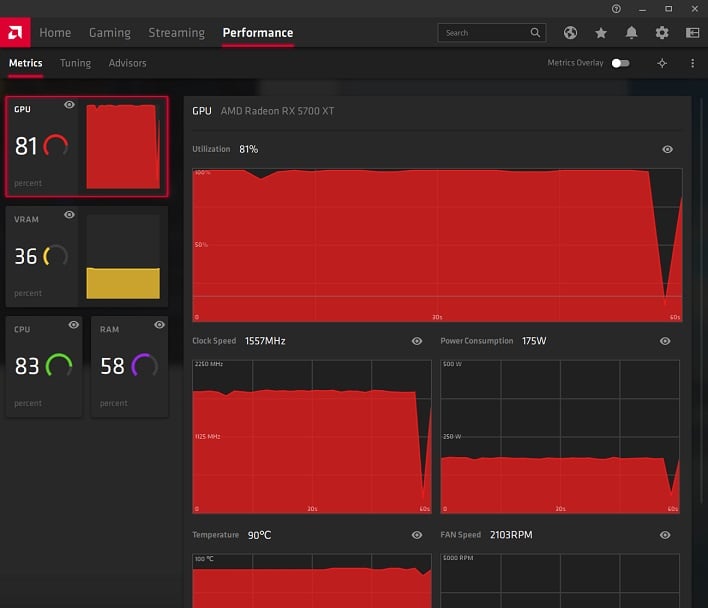
Loads of performance metrics at the touch of a button
The performance page shows useful information about the graphics card in the Metrics page. Here you can see GPU utilization, temperatures, fan information, CPU and RAM usage, and so on. The Tuning page lets you automatically overclock or undervolt your graphics card when a given application is running. If a title requires every last ounce of performance, Radeon Software can automatically overclock the graphics card. On the other hand, if the game doesn't need quite as much as it's capable of pumping out, this page has controls for undervolting the GPU to save on heat and fan noise. We'll see how the automated overclock works later on.
AMD Link Enhancements
Radeon Link is a mobile application that gives users the ability to monitor performance from their tablet or smartphone. Now it's also an app that can serve as a streaming client with a Radeon-equipped PC as the host. Radeon Link works on Android TV and Apple's tvOS so you can stream from your PC to the TV in your living room, too. This is effectively a more open and more compatible version of NVIDIA's in-home streaming with the Shield family, but not as open as Steam in-home streaming, since you do need an AMD graphics card to use it.Along with TV streaming, AMD Link will enable remote play on mobile devices. Controller overlays allow mobile phones and tablets to be streaming clients. These software controls map to a standard game controller, so dual analog sticks, a D-pad, four face buttons, and four shoulder buttons are available as if you were playing with an Xbox controller. AMD is also releasing a new interface for the Link app, which will look very much like the redesigned Radeon Software we're looking at today.
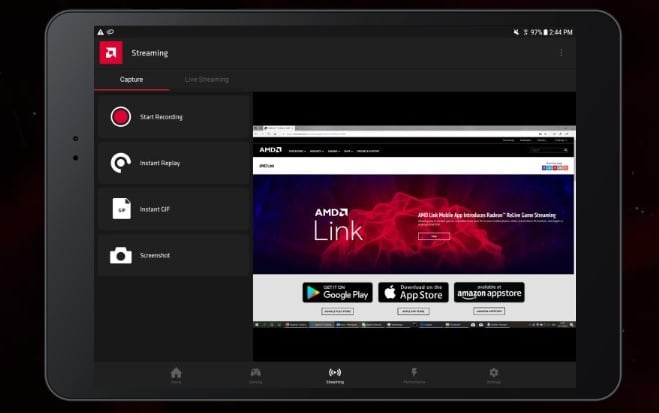
New features and a new UI are coming to AMD Link soon
These features are coming soon. The updated Android version of AMD Link should be available today from the app's Google Play listing. iOS users will have to wait a bit—that version is scheduled to be released on December 23.
New Gaming And GPU Features
Earlier this year, both Intel and NVIDIA announced integer scaling in their drivers. This feature, which we explored in-depth back in September, can scale lower-resolution images by a whole-number factor with nearest-neighbor scaling to display them as tack-sharp retro style images. With Radeon Software Adrenaline 2020 Edition, AMD joins the integer scaling club, so now all three major GPU vendors are on board. What AMD has that the other vendors don't is a per-game integer scaling setting, so we can turn it on for games that need it and leave it alone for the rest.Integer Scaling joins Radeon Image Sharpening to create a formidable one-two combination of image sharpening tools. When RIS was announced, it was a Navi-only feature. Now, that support has been expanded to include not only the Vega GPU architecture, but all the way back to GCN cards, too. Raven Ridge's Vega-based integrated graphics gain support, as well. AMD has also extended RIS to work with DirectX 11 titles, too.
That's not all older cards get, either. Other Navi-only features have made their way down the product line-up. Radeon Anti-Lag, which is AMD's solution for reducing the time between when an application captures input and that input happens on-screen, is now available for anything with a GCN or newer architecture, too.
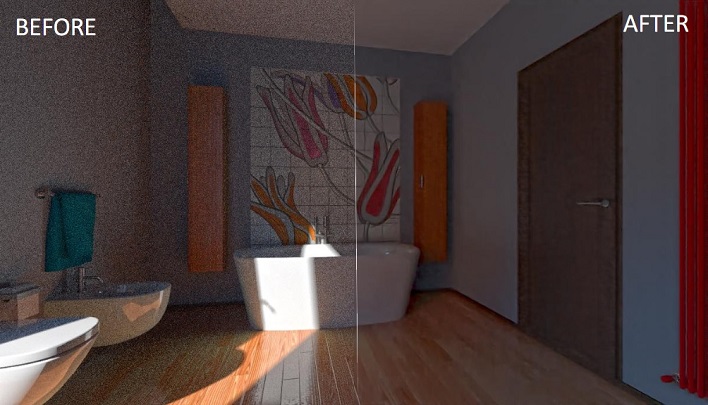
Games aren't the only media that AMD's drivers can clean up. The company has also introduced DirectML Media Filters, which apply machine learning de-noise and up-scaling algorithms to photos and video. This requires a Vega graphics card or newer, so GCN and Polaris are left out.
Radeon Performance Features
Many games have controls built in for dynamically changing the render target resolution depending on performance. For example, Gears 5 does a wonderful job of implementing dynamic resolutions to push frame rates upward. Choose a target resolution and framerate, and the game automatically gets as close as it can to those settings. However, what happens when a game doesn't support that? Enter Radeon Boost.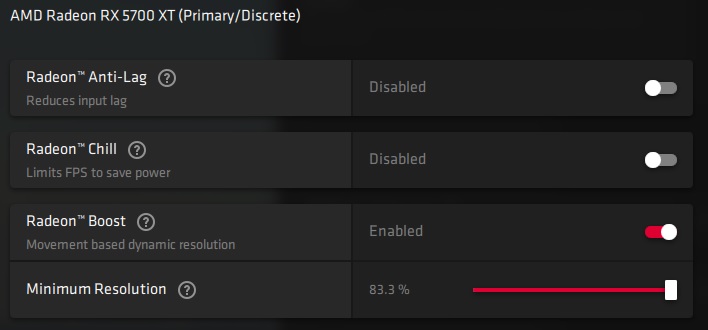
With Radeon Boost, the driver can set the resolution dynamically when you're in motion. Let go of all the controls, and the scaling stops—you'll be back at the game's selected resolution. The Minimum Resolution slider chooses a percentage of the game's render resolution to use as a baseline, between 50 and 83.3%. That means you can game at 4K, but if the graphics card isn't up to the task all the time, the resolution will scale back by up to 50% (1080p, in this example) to buy some additional performance.
Early on, Radeon Boost only supports eight games at release, but AMD says more are on the way. The full list of games includes Borderlands 3, Call of Duty: WWII, Destiny 2, Grand Theft Auto V, Overwatch, PUBG, Rise of the Tomb Raider, and Shadow of the Tomb Raider. Out of those games, Shadow of the Tomb Raider is already a benchmark staple here at HH, so it's a natural fit for testing at 3840x2160. DirectX 11 is required for Radeon Boost, so that's the mode we used for testing.

For reference, we tested on a Core i5-9600K with 16GB of DDR4-3000 memory and a Radeon RX 5700 XT. This card is perfectly capable of playing Tomb Raider at 4K with some settings tweaks on its own, but we wanted to see what kind of performance boost we could wring out of our midrange test bed using Radeon Boost. Our gut is that we might not notice the resolution dip, even at 50%, while we're in motion. Since we can move our character, capture frame times, and hit the Print Screen key at the same time, we can perform our own analysis.

Testing Radeon Boost is as simple as firing up a supported game and then using GPUOpen's OCAT overlay to monitor frame times and frame rates. After playing through the intro of Tomb Raider, we wandered around Cozumel's Day of the Dead celebration.
You can kick Radeon Boost on by holding down a modifier key, like the right Shift key. That let us grab a couple of identical images to compare quality. What's immediately apparent with Radeon Boost enabled is that the game is rendering at a much lower resolution. What's less obvious from still pictures is that we had a hard time seeing this while moving.
The best way to get a feel for the performance increase is to watch the frame times first while standing still, then while moving around. We did this for a while to see how the game felt, and then we turned Radeon Boost off using the Alt+K hotkey. The difference in feel was pretty immediate.
To test Radeon Boost for real, however, we wanted it to be on all the time so we can see how quickly it can shift gears between the game's specified resolution and the faster low-res images. We just stood still in Tomb Raider's Cozumel and held the right Shift key as mentioned above. When we wanted to turn off Radeon Boost, we just let go of the key.
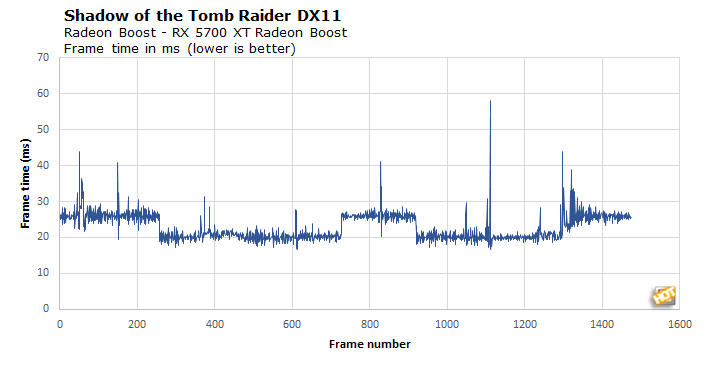
Toggling Radeon Boost worked just as well with an Xbox controller, too. Whatever your preferred input method, Radeon Boost, in this case, was able to pump frame rates upward by around 25%, and at these somewhat lower frame rates, that was a very perceptible feeling.
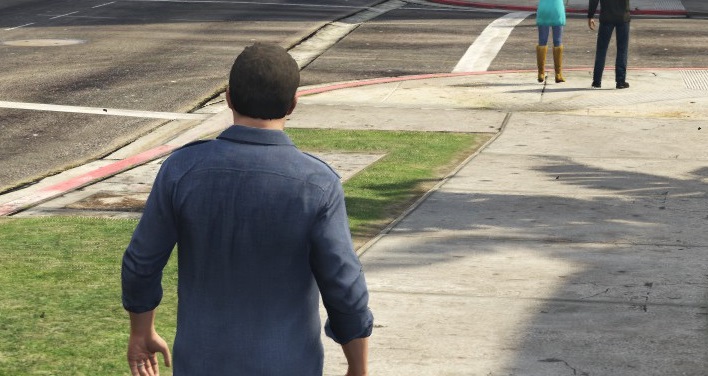
We also had Grand Theft Auto V handy for testing, so we gave that a go, too. Once again we set the game's resolution to 3840x2160 and just wandered around San Andreas for a while. OCAT's overlay once again showed a big difference in frame rates between just standing around and actually moving. Also just like with Tomb Raider, we could toggle Radeon Boost just by pressing down the shift key, as if we were going to take off running.
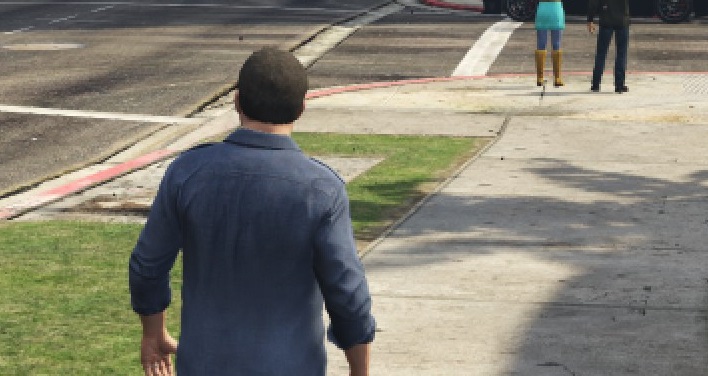
Much like Tomb Raider, Radeon Boost cut around 25% off of frame times, with a correlating 25% frame rate bump. At 4K with all the settings cranked to their maximum and MSAA turned up to 8x, our Radeon RX 5700 XT PC churned out around 30 frames per second, with frame times hovering around 33 milliseconds. That's a ton of high-quality pixels in each of those frames. With Radeon Boost enabled, that number jumped up to 37 to 38 frames per second. Frame times did a nice job of hovering steadily around 23 to 24 milliseconds. Very rarely was there ever a spike, but GTAV runs pretty well on any modern setup these days.
While the shift in image quality is noticeable when there's not much going on, in the heat of battle those extra frames can come in handy. It's not the same frame rate as if we ran the game at 1080p natively, but the game is still drawing a full 4K image.
Conclusions
While the touted performance increases in Radeon Software Adrenalin 2020 Edition AMD claims over last year's drivers are impressive, folks who keep their drivers up to date have been getting them piecemeal over the last 12 months already. For folks who still need more performance, Radeon Boost is an interesting way to get it through a mix of native rendering and lower-resolution shortcuts that give a nice boost to performance when you actually need it. Boost might trim back some of the image quality, but in high-action games, we don't think most folks will really notice. It does live up to its billing, though, and that's all we can ask.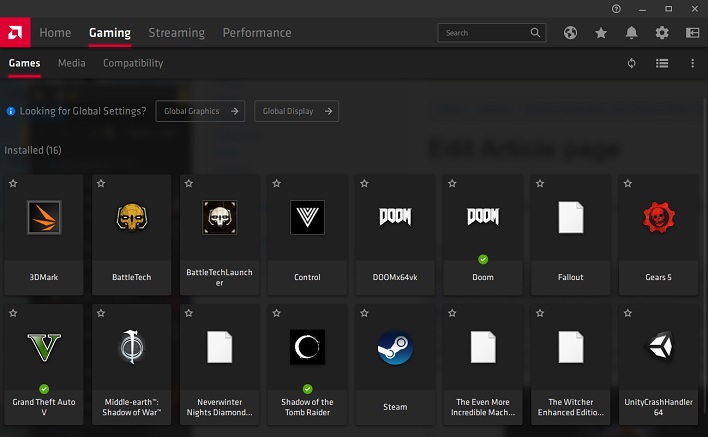
Detected games, each one ready for its own game-specific profile
Instead, what's really impressive about the overhauled Radeon Software interface is how easily we could get to features that mattered. AMD really gives its users control over how Radeon graphics cards run, along with the immediate and easily-surfaced metrics to provide feedback. Regardless of what features are most attractive to you, if you've got a Radeon card, you'll no doubt want to stay current for new game support. The extra features and performance that AMD packed into its latest drivers are no doubt some tasty icing on the cake. We're looking forward to finding out what the red team has cooked up next.

